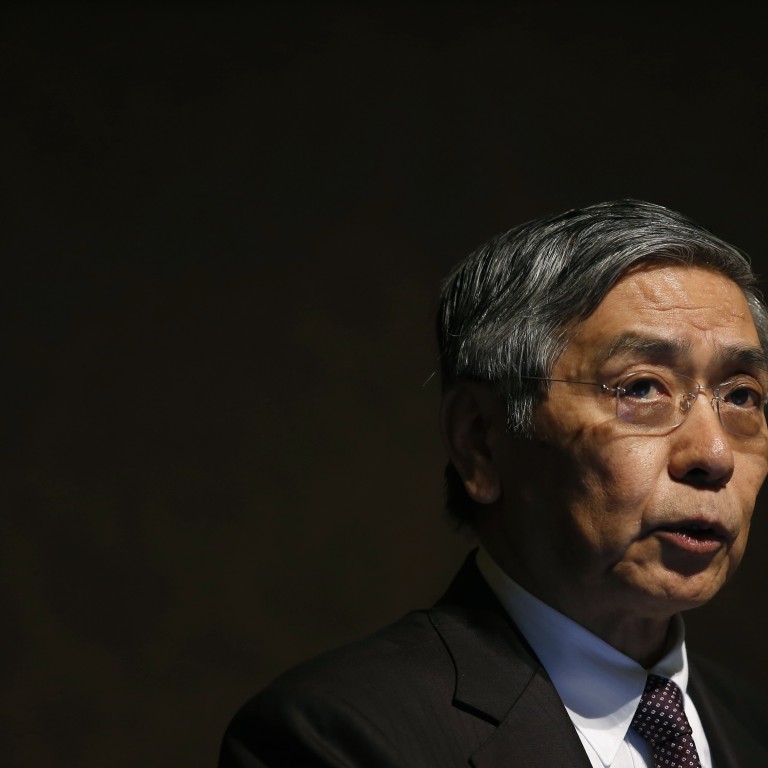
Japan's 'shock and awe' stimulus shows economies' desperate faith in monetary easing
Andrew Sheng says where structural reforms stall, we reach for unconventional monetary policy
On October 29, the US Federal Reserve Board announced the end of the third round of quantitative easing - purchases of Treasury bonds and agency mortgage-backed securities to keep the economy going. Instead of reacting negatively to this withdrawal of stimulus, the US stock market reached record highs. This was because the market read the Fed announcement on interest rates as dovish, an intention to keep them low.
Just days later, Bank of Japan governor Haruhiko Kuroda announced the opposite view, that in pursuit of its quantitative and qualitative monetary easing, the BOJ "will do whatever it can to overcome the deflation that has long undermined the Japanese economy". The stimulus move seeks to achieve an inflation target of 2 per cent per annum within two years. The new measures will increase the monetary base and the amount of bonds held by the BOJ while tripling the annual purchases of exchange-traded funds and Japan real estate investment trusts. The Nikkei stock index went up, despite the gloomy world outlook.
In plain language, the BOJ is not only willing to increase its bond and stock index purchases, but also increase its monetary base, namely, partly by printing money. Central banks have always been careful to distinguish between quantitative easing by buying bonds from the market, which tends to increase the liquidity of banks, from the actual printing of money through its monetary base. Technically, the first action swaps bonds held by banks and asset managers into deposits with the central bank, while the second creates the money by buying the bond outright.
Quantitative easing was introduced in 2008 when central banks lowered interest rates to near zero. The European Central Bank recently even breached this zero level with negative interest rates, charging banks for putting money with it. However, the ECB has been the most cautious in using monetary easing, having doubled its balance sheet between 2011 and 2012, when president Mario Draghi announced "whatever it takes" to stop the European debt crisis. But, since 2012, the ECB has withdrawn quite a lot of its asset purchases, because the surplus economies like Germany prefer more cautious monetary policy.
We should look at quantitative easing in perspective. Since 2008, the Fed has increased its balance sheet five times, the Bank of England just over four times, and the Bank of Japan 2½ times, while the ECB's is about 40 per cent higher than its 2008 level. These are historically unprecedented.
The bottom line is that the US and British economies have recovered somewhat, but remain below their long-term potential. The Japanese economy is still flattish, and the European economy threatens to enter deflation. This is despite the fact that world oil prices are declining, which is good for stimulating consumption.
The desire in the advanced countries for higher inflation is convoluted. On the one hand, they think that with higher liquidity and inflation, consumption will actually increase. On the other, the overhang of their fiscal debt, which is the highest since the second world war, can only be reduced through higher inflation. But, instead, quantitative easing has increased asset prices.
Nobel Laureate Paul Krugman did something remarkable last week when he said in his column that Western economists should apologise for criticising Japan for responding "too slowly" with its economic policy. Japan was the first to fall into the "debt deflation" trap, and tried everything from fiscal pumping and loose monetary policy to deal with it, without much success. Krugman thinks the West not only did not learn from Japan, but performed worse.
The problem with clever economics is that reality is never congruent with elegant theory. Central bankers stepped in with unconventional monetary policy because politicians couldn't do the unpleasant task of making structural reforms. Japanese stimulus is necessarily "shock and awe" because the third arrow of structural reforms in Abenomics has not been delivered. Japan is still going through its balance sheet recession, and even though its latest move is not directed at the exchange rate, a depreciation of the yen is critical to the rewriting of the national balance sheet.
At the end of 2012, Japan had 296 trillion yen (HK$20 trillion) of net foreign assets, or about 60 per cent of gross domestic product. The BOJ estimated that a 1 per cent depreciation of the yen would increase net foreign assets by 1.2 per cent, or 3.7 trillion yen. Since 2012, the yen has depreciated nearly 25 per cent. By the same token, the net foreign asset value has increased by 30 per cent. In short, in yen terms, there is a large positive wealth effect for the Japanese economy from the devaluation, on top of the gain in export competitiveness.
If this still does not work, something is seriously wrong with either economic theory or the Japanese economy.

